Paper Menu >>
Journal Menu >>
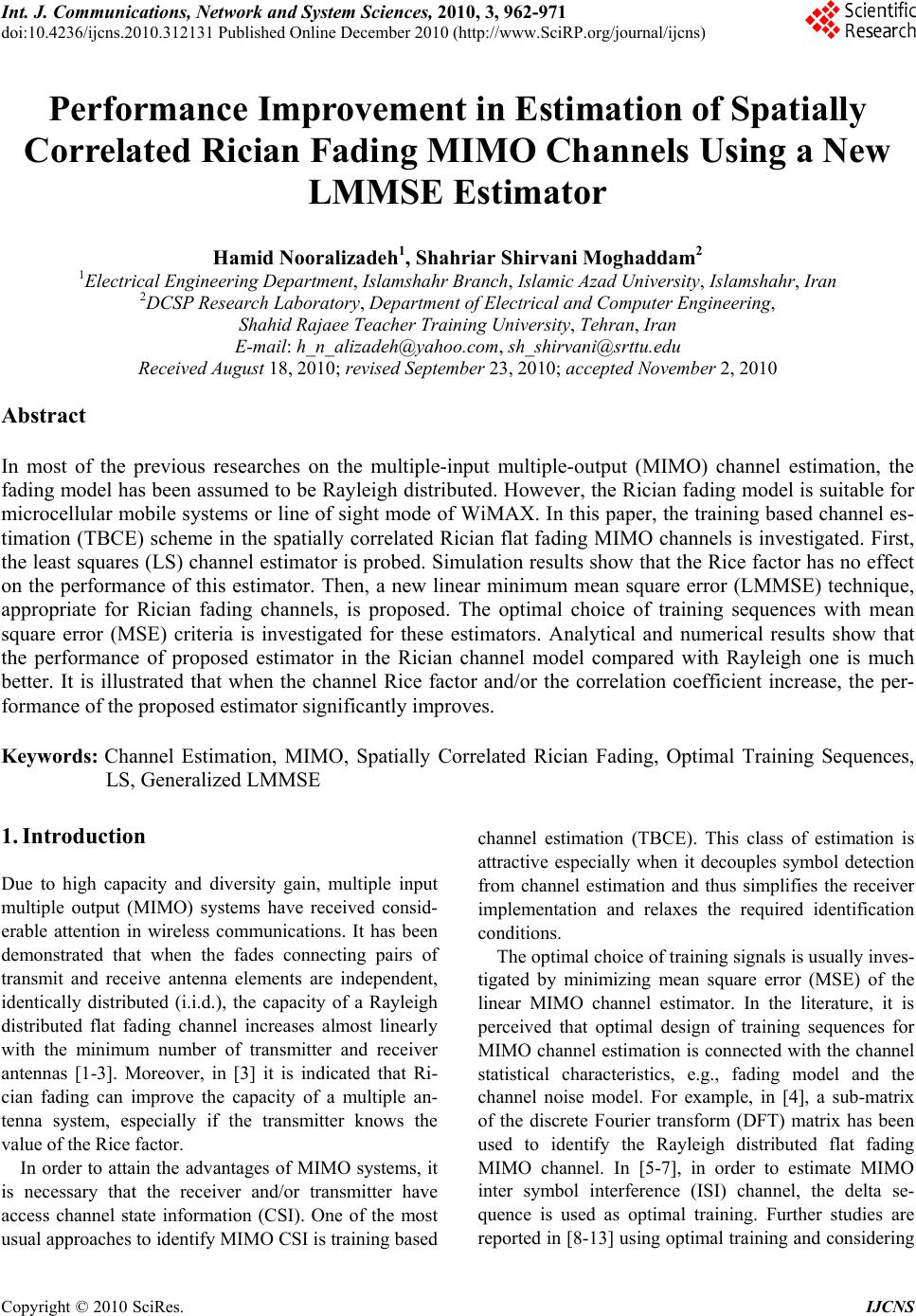 Int. J. Communications, Network and System Sciences, 2010, 3, 962-971 doi:10.4236/ijcns.2010.312131 Published Online December 2010 (http://www.SciRP.org/journal/ijcns) Copyright © 2010 SciRes. IJCNS Performance Improvement in Estimation of Spatially Correlated Rician Fading MIMO Channels Using a New LMMSE Estimator Hamid Nooralizadeh1, Shahriar Shirvani Moghaddam2 1Electrical Engineering Department, Islamshahr Branch, Islamic Azad University, Islamshahr, Iran 2DCSP Research Laboratory, Department of Electrical and Computer Engineering, Shahid Rajaee Teacher Training University, Tehran, Iran E-mail: h_n_alizadeh@yahoo.com, sh_shirvani@srttu.edu Received August 18, 2010; revised September 23, 2010; accepted November 2, 2010 Abstract In most of the previous researches on the multiple-input multiple-output (MIMO) channel estimation, the fading model has been assumed to be Rayleigh distributed. However, the Rician fading model is suitable for microcellular mobile systems or line of sight mode of WiMAX. In this paper, the training based channel es- timation (TBCE) scheme in the spatially correlated Rician flat fading MIMO channels is investigated. First, the least squares (LS) channel estimator is probed. Simulation results show that the Rice factor has no effect on the performance of this estimator. Then, a new linear minimum mean square error (LMMSE) technique, appropriate for Rician fading channels, is proposed. The optimal choice of training sequences with mean square error (MSE) criteria is investigated for these estimators. Analytical and numerical results show that the performance of proposed estimator in the Rician channel model compared with Rayleigh one is much better. It is illustrated that when the channel Rice factor and/or the correlation coefficient increase, the per- formance of the proposed estimator significantly improves. Keywords: Channel Estimation, MIMO, Spatially Correlated Rician Fading, Optimal Training Sequences, LS, Generalized LMMSE 1. Introduction Due to high capacity and diversity gain, multiple input multiple output (MIMO) systems have received consid- erable attention in wireless communications. It has been demonstrated that when the fades connecting pairs of transmit and receive antenna elements are independent, identically distributed (i.i.d.), the capacity of a Rayleigh distributed flat fading channel increases almost linearly with the minimum number of transmitter and receiver antennas [1-3]. Moreover, in [3] it is indicated that Ri- cian fading can improve the capacity of a multiple an- tenna system, especially if the transmitter knows the value of the Rice factor. In order to attain the advantages of MIMO systems, it is necessary that the receiver and/or transmitter have access channel state information (CSI). One of the most usual approaches to identify MIMO CSI is training based channel estimation (TBCE). This class of estimation is attractive especially when it decouples symbol detection from channel estimation and thus simplifies the receiver implementation and relaxes the required identification conditions. The optimal choice of training signals is usually inves- tigated by minimizing mean square error (MSE) of the linear MIMO channel estimator. In the literature, it is perceived that optimal design of training sequences for MIMO channel estimation is connected with the channel statistical characteristics, e.g., fading model and the channel noise model. For example, in [4], a sub-matrix of the discrete Fourier transform (DFT) matrix has been used to identify the Rayleigh distributed flat fading MIMO channel. In [5-7], in order to estimate MIMO inter symbol interference (ISI) channel, the delta se- quence is used as optimal training. Further studies are reported in [8-13] using optimal training and considering 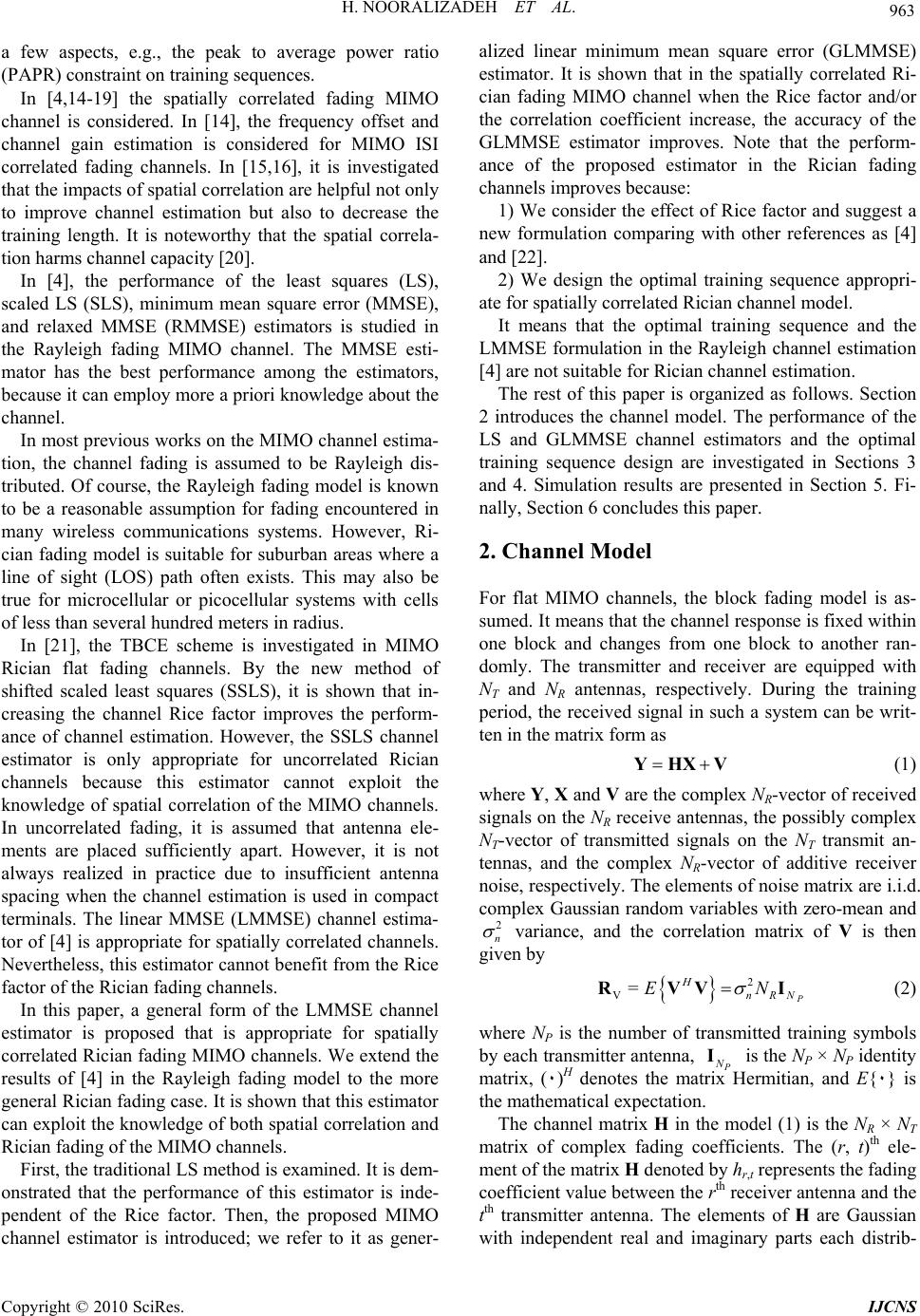 H. NOORALIZADEH ET AL. 963 a few aspects, e.g., the peak to average power ratio (PAPR) constraint on training sequences. In [4,14-19] the spatially correlated fading MIMO channel is considered. In [14], the frequency offset and channel gain estimation is considered for MIMO ISI correlated fading channels. In [15,16], it is investigated that the impacts of spatial correlation are helpful not only to improve channel estimation but also to decrease the training length. It is noteworthy that the spatial correla- tion harms channel capacity [20]. In [4], the performance of the least squares (LS), scaled LS (SLS), minimum mean square error (MMSE), and relaxed MMSE (RMMSE) estimators is studied in the Rayleigh fading MIMO channel. The MMSE esti- mator has the best performance among the estimators, because it can employ more a priori knowledge about the channel. In most previous works on the MIMO channel estima- tion, the channel fading is assumed to be Rayleigh dis- tributed. Of course, the Rayleigh fading model is known to be a reasonable assumption for fading encountered in many wireless communications systems. However, Ri- cian fading model is suitable for suburban areas where a line of sight (LOS) path often exists. This may also be true for microcellular or picocellular systems with cells of less than several hundred meters in radius. In [21], the TBCE scheme is investigated in MIMO Rician flat fading channels. By the new method of shifted scaled least squares (SSLS), it is shown that in- creasing the channel Rice factor improves the perform- ance of channel estimation. However, the SSLS channel estimator is only appropriate for uncorrelated Rician channels because this estimator cannot exploit the knowledge of spatial correlation of the MIMO channels. In uncorrelated fading, it is assumed that antenna ele- ments are placed sufficiently apart. However, it is not always realized in practice due to insufficient antenna spacing when the channel estimation is used in compact terminals. The linear MMSE (LMMSE) channel estima- tor of [4] is appropriate for spatially correlated channels. Nevertheless, this estimator cannot benefit from the Rice factor of the Rician fading channels. In this paper, a general form of the LMMSE channel estimator is proposed that is appropriate for spatially correlated Rician fading MIMO channels. We extend the results of [4] in the Rayleigh fading model to the more general Rician fading case. It is shown that this estimator can exploit the knowledge of both spatial correlation and Rician fading of the MIMO channels. First, the traditional LS method is examined. It is dem- onstrated that the performance of this estimator is inde- pendent of the Rice factor. Then, the proposed MIMO channel estimator is introduced; we refer to it as gener- alized linear minimum mean square error (GLMMSE) estimator. It is shown that in the spatially correlated Ri- cian fading MIMO channel when the Rice factor and/or the correlation coefficient increase, the accuracy of the GLMMSE estimator improves. Note that the perform- ance of the proposed estimator in the Rician fading channels improves because: 1) We consider the effect of Rice factor and suggest a new formulation comparing with other references as [4] and [22]. 2) We design the optimal training sequence appropri- ate for spatially correlated Rician channel model. It means that the optimal training sequence and the LMMSE formulation in the Rayleigh channel estimation [4] are not suitable for Rician channel estimation. The rest of this paper is organized as follows. Section 2 introduces the channel model. The performance of the LS and GLMMSE channel estimators and the optimal training sequence design are investigated in Sections 3 and 4. Simulation results are presented in Section 5. Fi- nally, Section 6 concludes this paper. 2. Channel Model For flat MIMO channels, the block fading model is as- sumed. It means that the channel response is fixed within one block and changes from one block to another ran- domly. The transmitter and receiver are equipped with NT and NR antennas, respectively. During the training period, the received signal in such a system can be writ- ten in the matrix form as YHXV (1) where Y, X and V are the complex NR-vector of received signals on the NR receive antennas, the possibly complex NT-vector of transmitted signals on the NT transmit an- tennas, and the complex NR-vector of additive receiver noise, respectively. The elements of noise matrix are i.i.d. complex Gaussian random variables with zero-mean and 2 n variance, and the correlation matrix of V is then given by 2 VP nRN =E N RVV I (2) where NP is the number of transmitted training symbols by each transmitter antenna, P I N is the NP × NP identity matrix, (٠)H denotes the matrix Hermitian, and E{٠} is the mathematical expectation. The channel matrix H in the model (1) is the NR × NT matrix of complex fading coefficients. The (r, t)th ele- ment of the matrix H denoted by hr,t represents the fading coefficient value between the rth receiver antenna and the tth transmitter antenna. The elements of H are Gaussian with independent real and imaginary parts each distrib- Copyright © 2010 SciRes. IJCNS 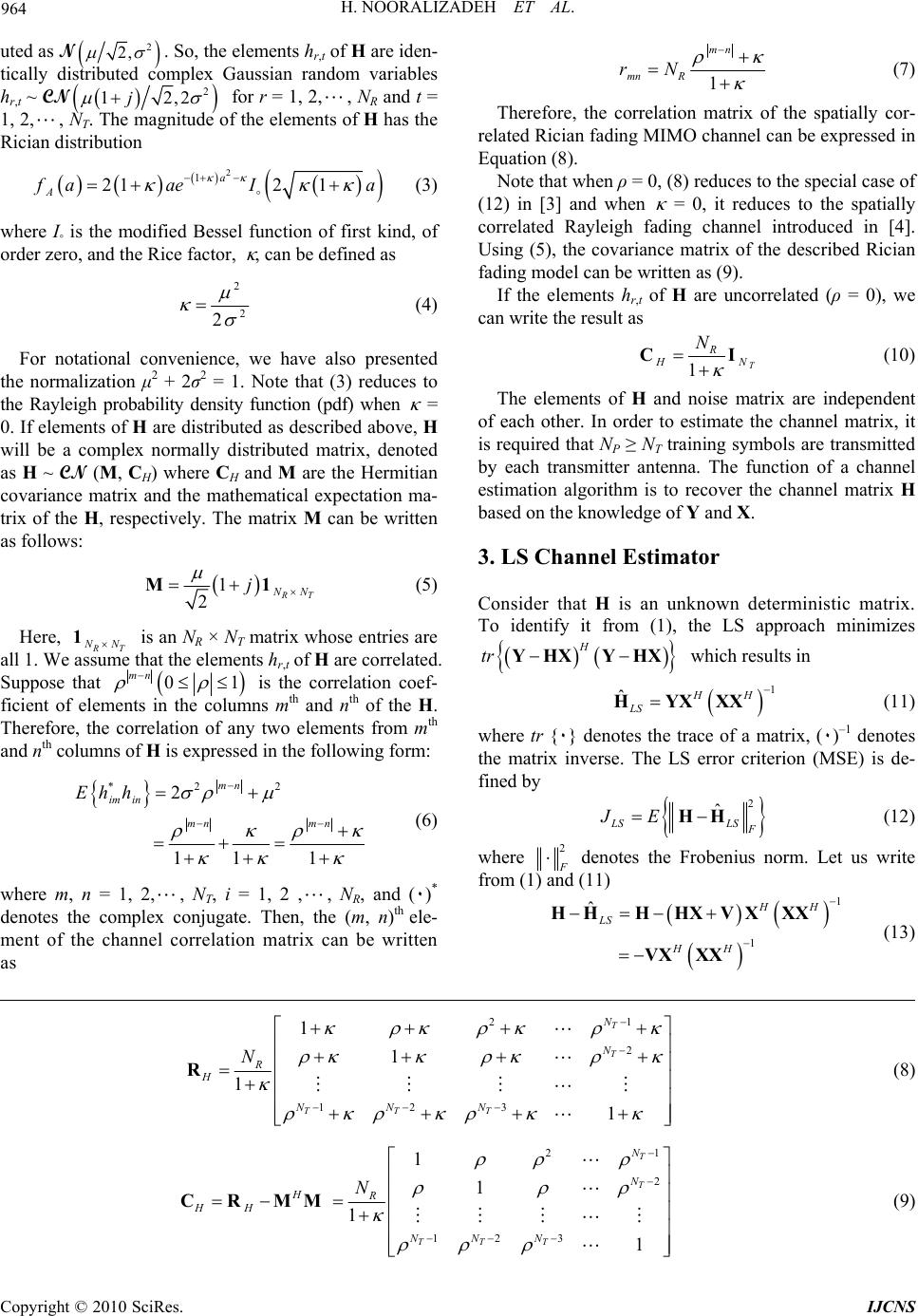 H. NOORALIZADEH ET AL. Copyright © 2010 SciRes. IJCNS 964 uted as N 2 2, . So, the elements hr,t of H are iden- tically distributed complex Gaussian random variables hr,t ~ CN 2 12,2j for r = 1, 2,, NR and t = 1, 2,, NT. The magnitude of the elements of H has the Rician distribution 1 mn mn R rN (7) 2 1 212 1 a A f aaeI Therefore, the correlation matrix of the spatially cor- related Rician fading MIMO channel can be expressed in Equation (8). a (3) Note that when ρ = 0, (8) reduces to the special case of (12) in [3] and when κ = 0, it reduces to the spatially correlated Rayleigh fading channel introduced in [4]. Using (5), the covariance matrix of the described Rician fading model can be written as (9). where I◦ is the modified Bessel function of first kind, of order zero, and the Rice factor, κ , can be defined as 2 2 2 If the elements hr,t of H are uncorrelated (ρ = 0), we can write the result as (4) 1T R H N N CI (10) For notational convenience, we have also presented the normalization μ2 + 2σ2 = 1. Note that (3) reduces to the Rayleigh probability density function (pdf) when κ = 0. If elements of H are distributed as described above, H will be a complex normally distributed matrix, denoted as H ~ CN (M, CH) where CH and M are the Hermitian covariance matrix and the mathematical expectation ma- trix of the H, respectively. The matrix M can be written as follows: The elements of H and noise matrix are independent of each other. In order to estimate the channel matrix, it is required that NP ≥ NT training symbols are transmitted by each transmitter antenna. The function of a channel estimation algorithm is to recover the channel matrix H based on the knowledge of Y and X. 3. LS Channel Estimator 1 2 R T N N j M1 (5) Consider that H is an unknown deterministic matrix. To identify it from (1), the LS approach minimizes H tr YHXYHX which results in Here, N R T N is an NR × NT matrix whose entries are all 1. We assume that the elements hr,t of H are correlated. Suppose that 1 0 mn 1 is the correlation coef- ficient of elements in the columns mth and nth of the H. Therefore, the correlation of any two elements from mth and nth columns of H is expressed in the following form: 1 ˆHH LS HYXXX (11) where tr {٠} denotes the trace of a matrix, (٠)–1 denotes the matrix inverse. The LS error criterion (MSE) is de- fined by *22 2 11 1 mn im in mn mn Eh h 2 ˆ LS LS F JEHH (12) (6) where 2 F denotes the Frobenius norm. Let us write from (1) and (11) where m, n = 1, 2,, NT, i = 1, 2 ,, NR, and (٠)* denotes the complex conjugate. Then, the (m, n)th ele- ment of the channel correlation matrix can be written as 1 1 ˆHH LS HH HHHHXVX XX VX XX (13) 1 2 2 123 1 1 1 1 T T TT T N N R H NN N N R (8) 1 2 2 123 1 1 1 1 T T TT T N N HR HH NN N N CRMM (9) 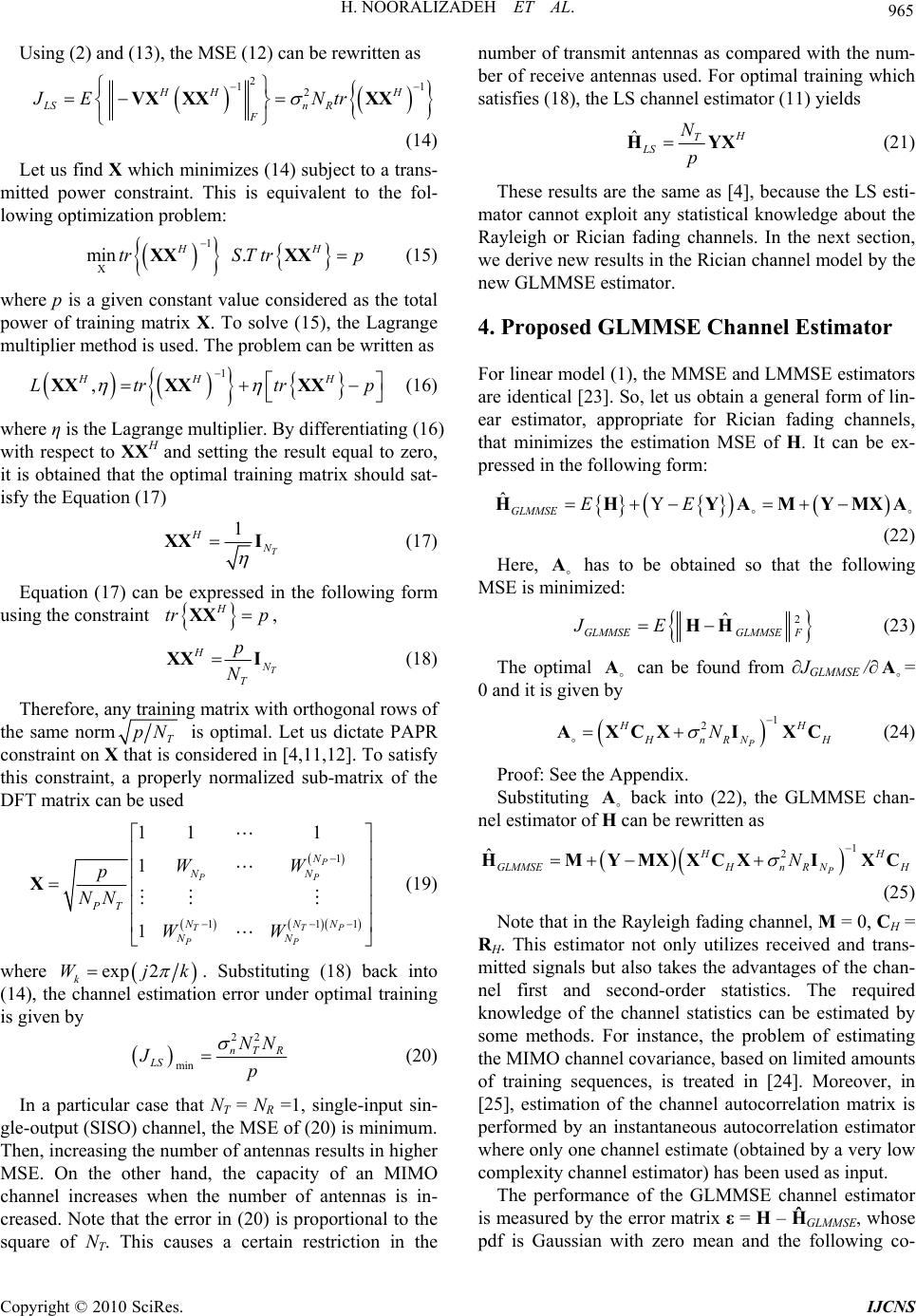 H. NOORALIZADEH ET AL. Copyright © 2010 SciRes. IJCNS 965 Using (2) and (13), the MSE (12) can be rewritten as 2 1 2HH H LSn R F JE Ntr VX XXXX 1 H p (14) Let us find X which minimizes (14) subject to a trans- mitted power constraint. This is equivalent to the fol- lowing optimization problem: 1 X min . H trS Ttrp XXXX (15) where p is a given constant value considered as the total power of training matrix X. To solve (15), the Lagrange multiplier method is used. The problem can be written as 1 , HH H Ltr tr XXXXXX (16) where η is the Lagrange multiplier. By differentiating (16) with respect to XXH and setting the result equal to zero, it is obtained that the optimal training matrix should sat- isfy the Equation (17) 1 T H N XXI (17) Equation (17) can be expressed in the following form using the constraint H tr p XX , T H N T p N XXI (18) Therefore, any training matrix with orthogonal rows of the same normT is optimal. Let us dictate PAPR constraint on X that is considered in [4,11,12]. To satisfy this constraint, a properly normalized sub-matrix of the DFT matrix can be used pN 1 11 11 1 1 1 P PP TT PP N NN PT NNN NN WW p NN WW 1 P X (19) where exp 2 k Wj k . Substituting (18) back into (14), the channel estimation error under optimal training is given by 22 min nTR LS NN Jp (20) In a particular case that NT = NR =1, single-input sin- gle-output (SISO) channel, the MSE of (20) is minimum. Then, increasing the number of antennas results in higher MSE. On the other hand, the capacity of an MIMO channel increases when the number of antennas is in- creased. Note that the error in (20) is proportional to the square of NT. This causes a certain restriction in the number of transmit antennas as compared with the num- ber of receive antennas used. For optimal training which satisfies (18), the LS channel estimator (11) yields ˆ H T LS N p HYX (21) These results are the same as [4], because the LS esti- mator cannot exploit any statistical knowledge about the Rayleigh or Rician fading channels. In the next section, we derive new results in the Rician channel model by the new GLMMSE estimator. 4. Proposed GLMMSE Channel Estimator For linear model (1), the MMSE and LMMSE estimators are identical [23]. So, let us obtain a general form of lin- ear estimator, appropriate for Rician fading channels, that minimizes the estimation MSE of H. It can be ex- pressed in the following form: ˆY GLMMSE EEHHYAMYM XA (22) Here, has to be obtained so that the following MSE is minimized: A 2 ˆ GLMMSEGLMMSE F JEHH (23) The optimal can be found from ∂JGLMMSE /∂= 0 and it is given by AA 1 2 P HH H nRN H N AXCXI XC (24) Proof: See the Appendix. Substituting back into (22), the GLMMSE chan- nel estimator of H can be rewritten as A 1 2 ˆ P HH GLMMSEHnR NH N HMYMXXCXIXC (25) Note that in the Rayleigh fading channel, M = 0, CH = RH. This estimator not only utilizes received and trans- mitted signals but also takes the advantages of the chan- nel first and second-order statistics. The required knowledge of the channel statistics can be estimated by some methods. For instance, the problem of estimating the MIMO channel covariance, based on limited amounts of training sequences, is treated in [24]. Moreover, in [25], estimation of the channel autocorrelation matrix is performed by an instantaneous autocorrelation estimator where only one channel estimate (obtained by a very low complexity channel estimator) has been used as input. The performance of the GLMMSE channel estimator is measured by the error matrix ε = H – ĤGLMMSE, whose pdf is Gaussian with zero mean and the following co-  966 H. NOORALIZADEH ET AL. variance matrix: 1 1 2 1- H-H H nR EN CR εε CXX (26) Therefore, the estimation error can be computed as 2 1 1 2 ˆ 1 H GLMMSEGLMMSE F H H nR JE Etr tr trN HH εε CC XX (27) Let us find X which minimizes the channel estimation error subject to a transmitted power constraint. Thus, we seek the matrix X that is the solution to the optimization problem (28) 1 1 2 1 min . HH H nR trS T trp N XCXX XX (28) To solve (28), the Lagrange multiplier method is ap- plied. The problem can be written as 1 1 2 1 , H H nR H LtrN tr p XXC XX XX H (29) By differentiating (29) with respect to XXH and equat- ing to zero, we have 2 2 T HnR 1 N nRH NN XXIC (30) Using the constraint , (30) can be ex- pressed as H tr pXX 21 2 T nR H H1 N nRH T pNtr N N C XXIC (31) By applying (31) in (27), 12 1 H HnR N CXX will be a diagonal matrix. Therefore, according to the lemma 1 in [4], we obtain that the MSE (27) will be minimized as 2 min 2 T GLMMSE Rn H N JpN tr C1 (32) In a particular case that the elements hr,t of H are un- correlated (ρ = 0), the covariance matrix of H is diagonal and from (10) 11 H T R tr N N C (33) Using (33), it is observed that (31) is the same as (18). It means that in the case of ρ = 0, both the LS and GLMMSE approaches have the same condition on the optimal training matrices. Using (10) and (18), the GLMMSE channel estimator (25) reduces to ˆ1 H GLMMSE HMYX (34) where 22 , 11 PP nP TnP NpN pNpN N T N (35) Substituting (33) back into (32), MSE in the particular case of ρ = 0 is given by (36) 2 min 21 RT GLMMSE nT NN JpN (36) Equation (36) shows that when the Rice factor, κ , increases, the MSE considerably decreases. In other words, in the Rician fading channel model compared with Rayleigh one, the obtained MSE improves. Increasing the channel Rice factor causes decreasing the MSE, and for higher values of κ , the MSE is proportional to 1/ κ . When κ = 0, (36) is identical to the acquired result in [4] for RMMSE channel estimator. In general, the covariance matrix of the H is given by (9) and the condition for the optimal training matrix of the GLMMSE channel estimator is different from that of the LS estimator. We seek the matrix X that is the solu- tion to (31). Thus, the eigen-value decomposition (EVD) of CH in the form of CH = QΛQH is used, where Λ is a diagonal matrix containing the nonnegative eigenvalues of the CH as its diagonal elements and Q is a unitary ma- trix containing the eigenvectors of the CH in its columns. Using this notation, (27) can be rewritten as 1 1 2 1 1 2 1 1 HH GLMMSE nR HH nR Jtr N tr N QΛQXX ΛQXXQ (37) Equation (37) can be reduced by replacing 2 1H nR N QX by X 1 1H GLMMSE Jtr ΛXX (38) Also, the total transmitted training power constraint in (28) can be rewritten in the following form: 22 1 HHH nR nR p tr tr NN XXQXX Q (39) Using lemma 1 of [4], the minimum of (38) will be obtained if X̃X̃H has the following diagonal structure: Copyright © 2010 SciRes. IJCNS 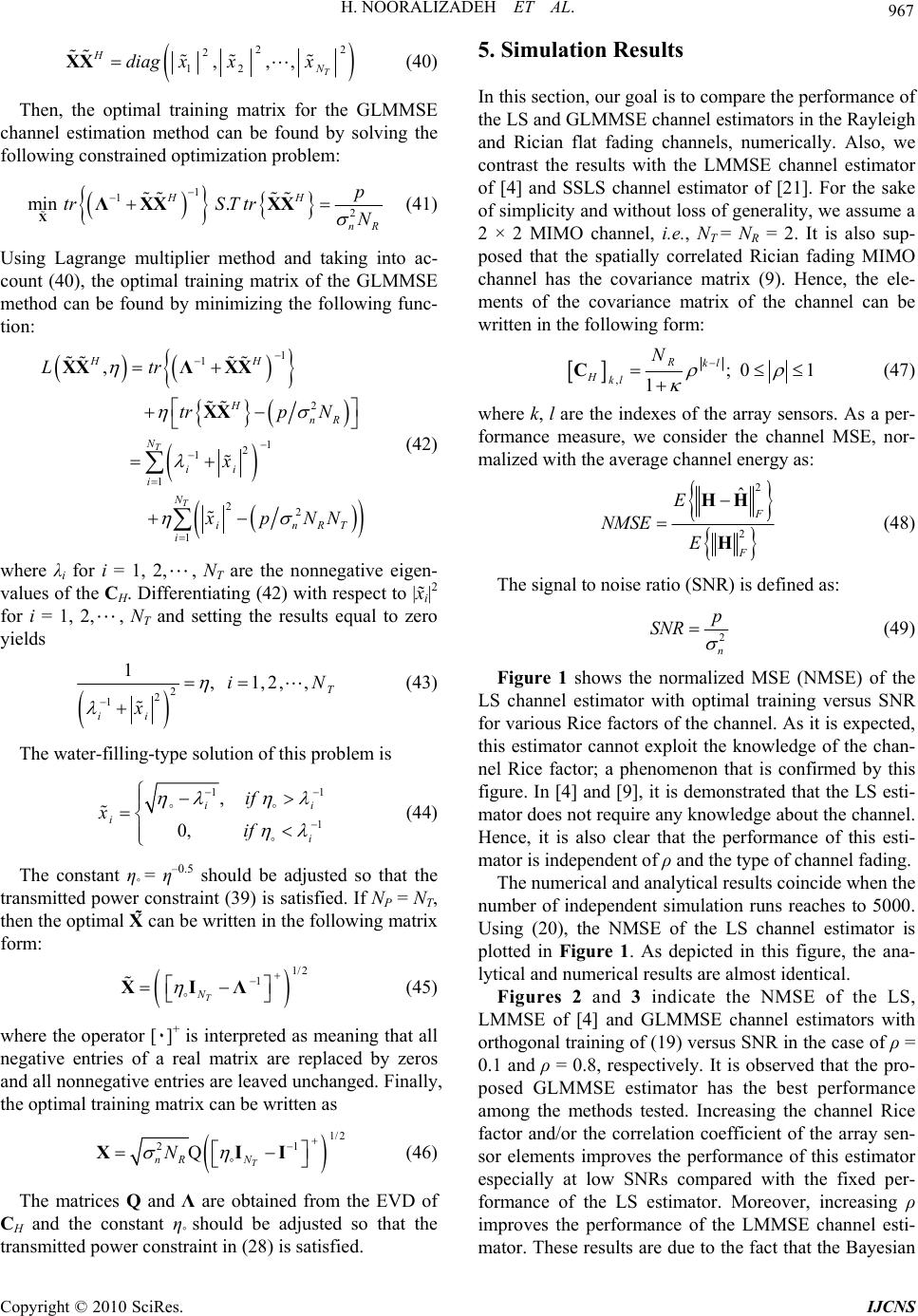 H. NOORALIZADEH ET AL. 967 2 2 2 12 ,,, T H N diag xxxXX (40) Then, the optimal training matrix for the GLMMSE channel estimation method can be found by solving the following constrained optimization problem: 1 1 2 min . HH nR p trS T trN X ΛXX XX (41) Using Lagrange multiplier method and taking into ac- count (40), the optimal training matrix of the GLMMSE method can be found by minimizing the following func- tion: 1 1 2 1 2 1 1 22 1 , T T HH H nR N ii i N inR i Ltr trp N x xpNN XX ΛXX XX T (42) where λi for i = 1, 2,, NT are the nonnegative eigen- values of the CH. Differentiating (42) with respect to |xi|2 for i = 1, 2,, NT and setting the results equal to zero yields 2 2 1 1,1,2,, T ii i x N (43) The water-filling-type solution of this problem is 11 1 , 0, i i i if x if i (44) The constant η◦ = η–0.5 should be adjusted so that the transmitted power constraint (39) is satisfied. If NP = NT, then the optimal X̃ can be written in the following matrix form: 1/2 1 T N XIΛ (45) where the operator [٠]+ is interpreted as meaning that all negative entries of a real matrix are replaced by zeros and all nonnegative entries are leaved unchanged. Finally, the optimal training matrix can be written as 1/2 2 QT nR N N XII 1 (46) The matrices Q and Λ are obtained from the EVD of CH and the constant η◦ should be adjusted so that the transmitted power constraint in (28) is satisfied. 5. Simulation Results In this section, our goal is to compare the performance of the LS and GLMMSE channel estimators in the Rayleigh and Rician flat fading channels, numerically. Also, we contrast the results with the LMMSE channel estimator of [4] and SSLS channel estimator of [21]. For the sake of simplicity and without loss of generality, we assume a 2 × 2 MIMO channel, i.e., NT = NR = 2. It is also sup- posed that the spatially correlated Rician fading MIMO channel has the covariance matrix (9). Hence, the ele- ments of the covariance matrix of the channel can be written in the following form: ,;0 1 1 Rkl Hkl N C (47) where k, l are the indexes of the array sensors. As a per- formance measure, we consider the channel MSE, nor- malized with the average channel energy as: 2 2 ˆ F F E NMSE E HH H (48) The signal to noise ratio (SNR) is defined as: 2 n p SNR (49) Figure 1 shows the normalized MSE (NMSE) of the LS channel estimator with optimal training versus SNR for various Rice factors of the channel. As it is expected, this estimator cannot exploit the knowledge of the chan- nel Rice factor; a phenomenon that is confirmed by this figure. In [4] and [9], it is demonstrated that the LS esti- mator does not require any knowledge about the channel. Hence, it is also clear that the performance of this esti- mator is independent of ρ and the type of channel fading. The numerical and analytical results coincide when the number of independent simulation runs reaches to 5000. Using (20), the NMSE of the LS channel estimator is plotted in Figure 1. As depicted in this figure, the ana- lytical and numerical results are almost identical. Figures 2 and 3 indicate the NMSE of the LS, LMMSE of [4] and GLMMSE channel estimators with orthogonal training of (19) versus SNR in the case of ρ = 0.1 and ρ = 0.8, respectively. It is observed that the pro- posed GLMMSE estimator has the best performance among the methods tested. Increasing the channel Rice factor and/or the correlation coefficient of the array sen- sor elements improves the performance of this estimator especially at low SNRs compared with the fixed per- formance of the LS estimator. Moreover, increasing ρ improves the performance of the LMMSE channel esti- mator. These results are due to the fact that the Bayesian Copyright © 2010 SciRes. IJCNS 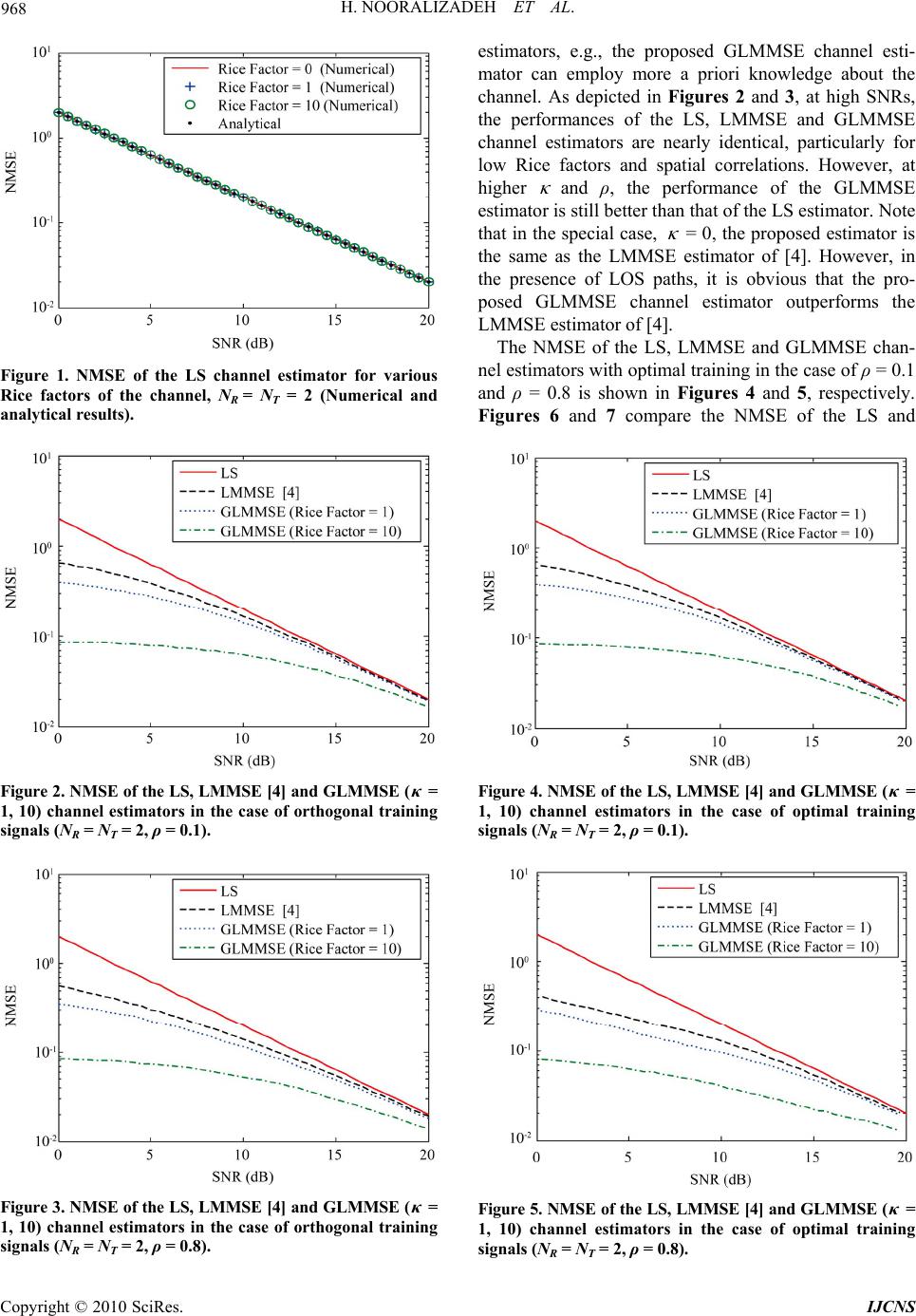 968 H. NOORALIZADEH ET AL. Figure 1. NMSE of the LS channel estimator for various Rice factors of the channel, NR = NT = 2 (Numerical and analytical results). Figure 2. NMSE of the LS, LMMSE [4] and GLMMSE ( κ = 1, 10) channel estimators in the case of orthogonal training signals (NR = NT = 2, ρ = 0.1). Figure 3. NMSE of the LS, LMMSE [4] and GLMMSE ( κ = 1, 10) channel estimators in the case of orthogonal training signals (NR = NT = 2, ρ = 0.8). estimators, e.g., the proposed GLMMSE channel esti- mator can employ more a priori knowledge about the channel. As depicted in Figures 2 and 3, at high SNRs, the performances of the LS, LMMSE and GLMMSE channel estimators are nearly identical, particularly for low Rice factors and spatial correlations. However, at higher κ and ρ, the performance of the GLMMSE estimator is still better than that of the LS estimator. Note that in the special case, κ = 0, the proposed estimator is the same as the LMMSE estimator of [4]. However, in the presence of LOS paths, it is obvious that the pro- posed GLMMSE channel estimator outperforms the LMMSE estimator of [4]. The NMSE of the LS, LMMSE and GLMMSE chan- nel estimators with optimal training in the case of ρ = 0.1 and ρ = 0.8 is shown in Figures 4 and 5, respectively. Figures 6 and 7 compare the NMSE of the LS and Figure 4. NMSE of the LS, LMMSE [4] and GLMMSE ( κ = 1, 10) channel estimators in the case of optimal training signals (NR = NT = 2, ρ = 0.1). Figure 5. NMSE of the LS, LMMSE [4] and GLMMSE ( κ = 1, 10) channel estimators in the case of optimal training signals (NR = NT = 2, ρ = 0.8). Copyright © 2010 SciRes. IJCNS 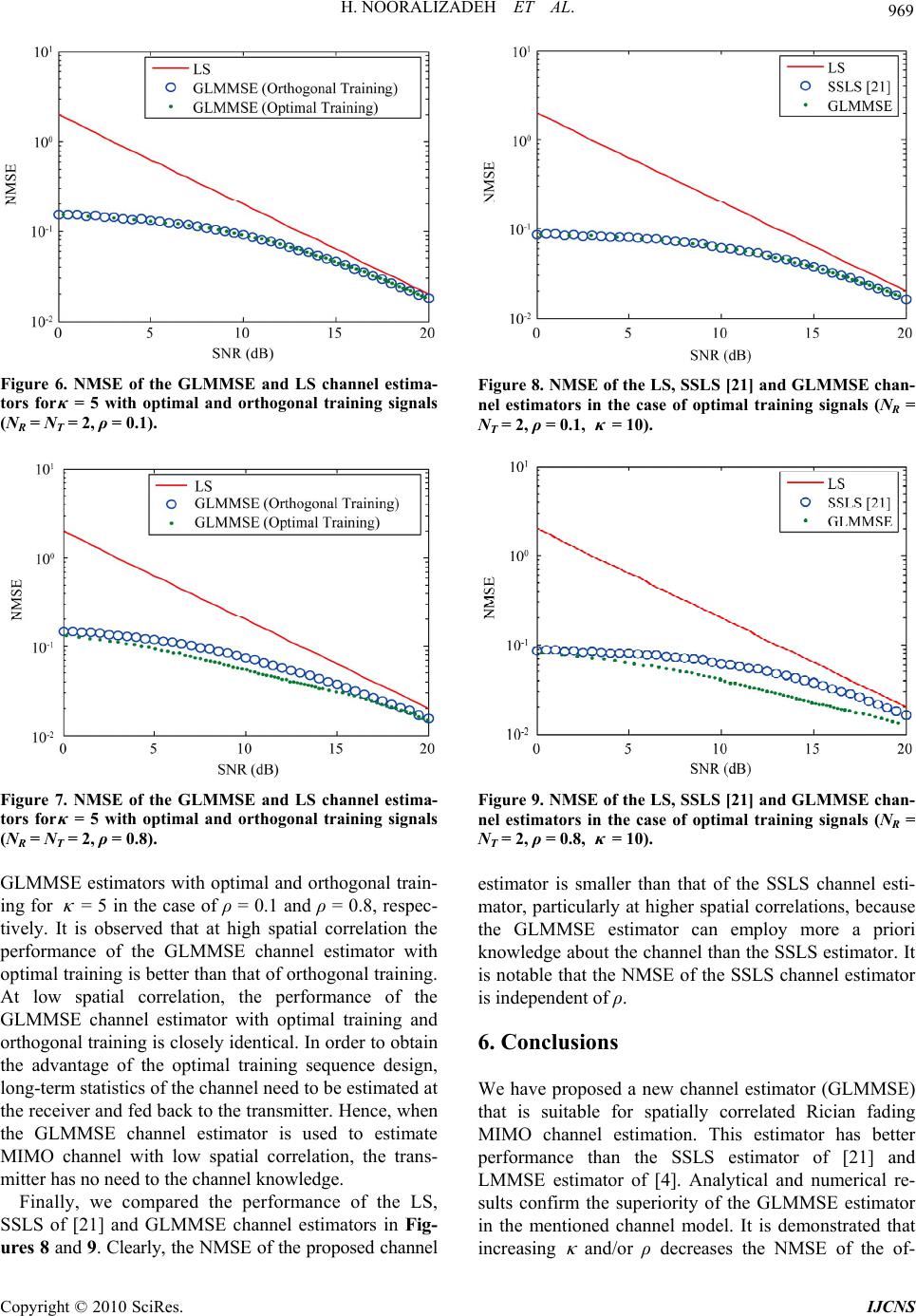 H. NOORALIZADEH ET AL. 969 Figure 6. NMSE of the GLMMSE and LS channel estima- tors for κ = 5 with optimal and orthogonal training signals (NR = NT = 2, ρ = 0.1). Figure 7. NMSE of the GLMMSE and LS channel estima- tors for κ = 5 with optimal and orthogonal training signals (NR = NT = 2, ρ = 0.8). GLMMSE estimators with optimal and orthogonal train- ing for κ = 5 in the case of ρ = 0.1 and ρ = 0.8, respec- tively. It is observed that at high spatial correlation the performance of the GLMMSE channel estimator with optimal training is better than that of orthogonal training. At low spatial correlation, the performance of the GLMMSE channel estimator with optimal training and orthogonal training is closely identical. In order to obtain the advantage of the optimal training sequence design, long-term statistics of the channel need to be estimated at the receiver and fed back to the transmitter. Hence, when the GLMMSE channel estimator is used to estimate MIMO channel with low spatial correlation, the trans- mitter has no need to the channel knowledge. Figure 8. NMSE of the LS, SSLS [21] and GLMMSE chan- nel estimators in the case of optimal training signals (NR = NT = 2, ρ = 0.1, κ = 10). Figure 9. NMSE of the LS, SSLS [21] and GLMMSE chan- nel estimators in the case of optimal training signals (NR = NT = 2, ρ = 0.8, κ = 10). estimator is smaller than that of the SSLS channel esti- mator, particularly at higher spatial correlations, because the GLMMSE estimator can employ more a priori knowledge about the channel than the SSLS estimator. It is notable that the NMSE of the SSLS channel estimator is independent of ρ. 6. Conclusions We have proposed a new channel estimator (GLMMSE) that is suitable for spatially correlated Rician fading MIMO channel estimation. This estimator has better performance than the SSLS estimator of [21] and LMMSE estimator of [4]. Analytical and numerical re- sults confirm the superiority of the GLMMSE estimator in the mentioned channel model. It is demonstrated that increasing κ and/or ρ decreases the NMSE of the of- Finally, we compared the performance of the LS, SSLS of [21] and GLMMSE channel estimators in Fig- ures 8 and 9. Clearly, the NMSE of the proposed channel Copyright © 2010 SciRes. IJCNS 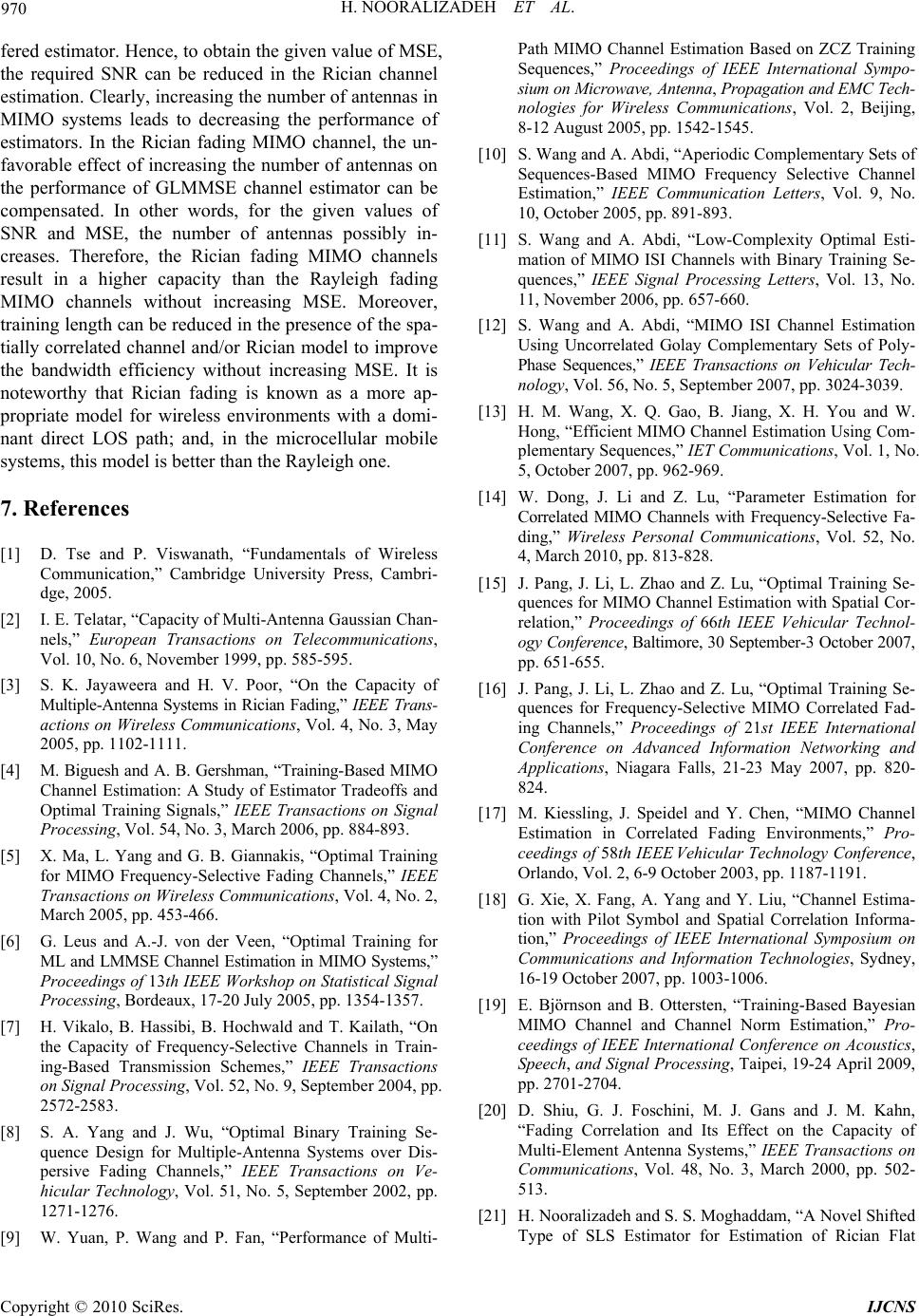 970 H. NOORALIZADEH ET AL. fered estimator. Hence, to obtain the given value of MSE, the required SNR can be reduced in the Rician channel estimation. Clearly, increasing the number of antennas in MIMO systems leads to decreasing the performance of estimators. In the Rician fading MIMO channel, the un- favorable effect of increasing the number of antennas on the performance of GLMMSE channel estimator can be compensated. In other words, for the given values of SNR and MSE, the number of antennas possibly in- creases. Therefore, the Rician fading MIMO channels result in a higher capacity than the Rayleigh fading MIMO channels without increasing MSE. Moreover, training length can be reduced in the presence of the spa- tially correlated channel and/or Rician model to improve the bandwidth efficiency without increasing MSE. It is noteworthy that Rician fading is known as a more ap- propriate model for wireless environments with a domi- nant direct LOS path; and, in the microcellular mobile systems, this model is better than the Rayleigh one. 7. References [1] D. Tse and P. Viswanath, “Fundamentals of Wireless Communication,” Cambridge University Press, Cambri- dge, 2005. [2] I. E. Telatar, “Capacity of Multi-Antenna Gaussian Chan- nels,” European Transactions on Telecommunications, Vol. 10, No. 6, November 1999, pp. 585-595. [3] S. K. Jayaweera and H. V. Poor, “On the Capacity of Multiple-Antenna Systems in Rician Fading,” IEEE Trans- actions on Wireless Communications, Vol. 4, No. 3, May 2005, pp. 1102-1111. [4] M. Biguesh and A. B. Gershman, “Training-Based MIMO Channel Estimation: A Study of Estimator Tradeoffs and Optimal Training Signals,” IEEE Transactions on Signal Processing, Vol. 54, No. 3, March 2006, pp. 884-893. [5] X. Ma, L. Yang and G. B. Giannakis, “Optimal Training for MIMO Frequency-Selective Fading Channels,” IEEE Transactions on Wireless Communications, Vol. 4, No. 2, March 2005, pp. 453-466. [6] G. Leus and A.-J. von der Veen, “Optimal Training for ML and LMMSE Channel Estimation in MIMO Systems,” Proceedings of 13th IEEE Workshop on Statistical Signal Processing, Bordeaux, 17-20 July 2005, pp. 1354-1357. [7] H. Vikalo, B. Hassibi, B. Hochwald and T. Kailath, “On the Capacity of Frequency-Selective Channels in Train- ing-Based Transmission Schemes,” IEEE Transactions on Signal Processing, Vol. 52, No. 9, September 2004, pp. 2572-2583. [8] S. A. Yang and J. Wu, “Optimal Binary Training Se- quence Design for Multiple-Antenna Systems over Dis- persive Fading Channels,” IEEE Transactions on Ve- hicular Technology, Vol. 51, No. 5, September 2002, pp. 1271-1276. [9] W. Yuan, P. Wang and P. Fan, “Performance of Multi- Path MIMO Channel Estimation Based on ZCZ Training Sequences,” Proceedings of IEEE International Sympo- sium on Microwave, Antenna, Propagation and EMC Tech- nologies for Wireless Communications, Vol. 2, Beijing, 8-12 August 2005, pp. 1542-1545. [10] S. Wang and A. Abdi, “Aperiodic Complementary Sets of Sequences-Based MIMO Frequency Selective Channel Estimation,” IEEE Communication Letters, Vol. 9, No. 10, October 2005, pp. 891-893. [11] S. Wang and A. Abdi, “Low-Complexity Optimal Esti- mation of MIMO ISI Channels with Binary Training Se- quences,” IEEE Signal Processing Letters, Vol. 13, No. 11, November 2006, pp. 657-660. [12] S. Wang and A. Abdi, “MIMO ISI Channel Estimation Using Uncorrelated Golay Complementary Sets of Poly- Phase Sequences,” IEEE Transactions on Vehicular Tech- nology, Vol. 56, No. 5, September 2007, pp. 3024-3039. [13] H. M. Wang, X. Q. Gao, B. Jiang, X. H. You and W. Hong, “Efficient MIMO Channel Estimation Using Com- plementary Sequences,” IET Communications, Vol. 1, No. 5, October 2007, pp. 962-969. [14] W. Dong, J. Li and Z. Lu, “Parameter Estimation for Correlated MIMO Channels with Frequency-Selective Fa- ding,” Wireless Personal Communications, Vol. 52, No. 4, March 2010, pp. 813-828. [15] J. Pang, J. Li, L. Zhao and Z. Lu, “Optimal Training Se- quences for MIMO Channel Estimation with Spatial Cor- relation,” Proceedings of 66th IEEE Vehicular Technol- ogy Conference, Baltimore, 30 September-3 October 2007, pp. 651-655. [16] J. Pang, J. Li, L. Zhao and Z. Lu, “Optimal Training Se- quences for Frequency-Selective MIMO Correlated Fad- ing Channels,” Proceedings of 21st IEEE International Conference on Advanced Information Networking and Applications, Niagara Falls, 21-23 May 2007, pp. 820- 824. [17] M. Kiessling, J. Speidel and Y. Chen, “MIMO Channel Estimation in Correlated Fading Environments,” Pro- ceedings of 58th IEEE Vehicular Technology Conference, Orlando, Vol. 2, 6-9 October 2003, pp. 1187-1191. [18] G. Xie, X. Fang, A. Yang and Y. Liu, “Channel Estima- tion with Pilot Symbol and Spatial Correlation Informa- tion,” Proceedings of IEEE International Symposium on Communications and Information Technologies, Sydney, 16-19 October 2007, pp. 1003-1006. [19] E. Björnson and B. Ottersten, “Training-Based Bayesian MIMO Channel and Channel Norm Estimation,” Pro- ceedings of IEEE International Conference on Acoustics, Speech, and Signal Processing, Taipei, 19-24 April 2009, pp. 2701-2704. [20] D. Shiu, G. J. Foschini, M. J. Gans and J. M. Kahn, “Fading Correlation and Its Effect on the Capacity of Multi-Element Antenna Systems,” IEEE Transactions on Communications, Vol. 48, No. 3, March 2000, pp. 502- 513. [21] H. Nooralizadeh and S. S. Moghaddam, “A Novel Shifted Type of SLS Estimator for Estimation of Rician Flat Copyright © 2010 SciRes. IJCNS  H. NOORALIZADEH ET AL. Copyright © 2010 SciRes. IJCNS 971 Fading MIMO Channels,” Signal Processing, Vol. 90, No. 6, June 2010, pp. 1887-1894. [24] K. Werner and M. Jansson, “Estimating MIMO Channel Covariances from Training Data under the Kronecker Model,” Signal Processing, Vol. 89, No. 1, January 2009, pp. 1-13. [22] L. Huang, G. Mathew and J. W. M. Bergmans, “Pilot- Aided Channel Estimation for Systems with Virtual Car- riers,” Proceedings of IEEE International Conference on Communications, Istanbul, 11-15 June 2006, pp. 3070-3075. [25] C. Mehlführer and M. Rupp, “Novel Tap-Wise LMMSE Channel Estimation for MIMO W-CDMA,” Proceedings of IEEE Global Telecommunications Conference, New Orleans, 30 November-4 December 2008, pp. 1-5. [23] S. M. Kay, “Fundamentals of Statistical Signal Process- ing, Volume I: Estimation Theory,” Prentice-Hall, Upper Saddle River, 1993. Appendix 2 TT HH GLMMSENHN H nR Jtr Ntr I AXCI XA AA (A-2) Proof of Equation (24): Using (22), the MSE (23) can be written as follows: 2 () GLMMSE F H JE Etr HM YMXA HM YMXA HM YMXA The optimal can be found from A (A-1) **2* 0 TT GLMMSE HH nR JN XCXC XAA A (A-3) where (٠)T denotes the matrix transpose. Finally, we have 1 2 P HH H nRN H N AXCXI XC (A-4) With some calculations, the MSE (A-1) is given by |

